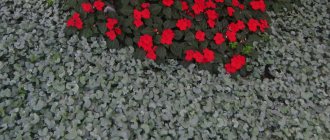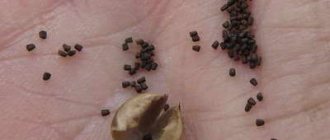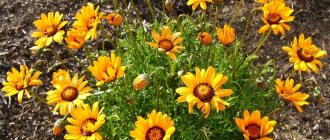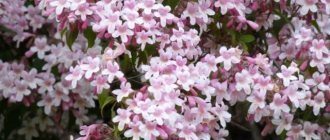Physostegia is a beautiful perennial with elegant voluminous pleiochasia, similar to spikelets of soft tones. This flower has only recently entered our gardens, but has become a true find for gardeners: its flowering occurs at the end of summer, at a time when most of the summer plantings have already faded, and the autumn ones are still producing buds. From mid-August until the cold weather, Physostegia brightens up the garden with pleiochasia of snow-white, milky, red, and dark purple flowers. The plant is also valued by florists for its ability to remain in the cut for a long time until the last bud opens. Physostegia - planting and care, photos of plants will help you grow a wonderful flower.
Description
Physostegia is a perennial herbaceous plant of the Lamiaceae family. Originally from North America. The name is formed by 2 Greek words, meaning “cover” and “bubble” in translation. This is explained by the swollen shape of the flower calyx. In the same way, physiostegia is called false snakehead.
They only grow Physostegia virginiana. This is a herbaceous crop 60–120 cm high. The stem is strong, erect, tetrahedral. The root system is creeping and grows vigorously. The leaves are elongated, lanceolate, have ragged edges, are found in pairs, sessile. Two-lipped tubular flowers are bisexual, less often unisexual. Painted in snow-white, light lilac, cherry color. The spike-shaped inflorescence can reach a length of 30 cm. Flowering begins in mid-summer and continues until the end of September. Fragrant flowers attract bees. The fruit becomes a small nut.
Popular varieties of the only species in cultivation
The genus is small; according to various sources, it includes 3–12 species. Only one grows in civilization.
Physostegia virginiana (lat. Physostegia virginiana). It has straight stems, slightly branched at the top, up to 90 cm in height. The leaves are rectilinear-lanceolate, opposite, light emerald. Snow-white, pink, violet, purple, lilac flowers are selected in a thick spike-shaped inflorescence. Winter hardiness is great. Fruits thoroughly and self-sows quickly.
A garden form of Physostegia virginiana, Physostegia “Alba,” has been bred. A bush up to 80 cm high with snow-white large flowers in a dense crown inflorescence. The flowers are large and snow-white.
Varieties worthy of attention:
- “Vivid” - up to 60 cm in height, flowers are pale pink;
- “Summer Snow” is a large (up to 90 cm) plant with white flowers;
- “Bouquet Rose” - can reach 120 cm in height with bright lilac flowers.
There is also a variegated (variegated) form with trunks that are most resistant to bending from the wind. The height of the bush does not exceed 90 cm. The leaves are emerald with a snow-white frame, the flowers are bright pink.
Landing
When planting, you should maintain an interval of 25-30 cm between plants. Physostegia is characterized by rapid growth of roots, which can displace other plants from the site. That’s why it’s so important to immediately create a restrictive system.
Plants can be planted in special containers. A bucket without a bottom or a fragment of an old pipe is suitable for this. In this case, the limiter is dug into the ground so that a layer of 20-50 mm remains from its top to the surface of the area. Often a plastic or metal fence is dug around the perimeter of the flower bed. Such sheets are dug into the ground 30-40 cm.
The plant grows quickly, this should be taken into account when planting
Physostegia - planting and care
Taking care of physiostegia is a pleasure. The crop, once in damp soil, quickly develops and produces numerous shoots. It gets sick very rarely, and develops well without frequent feeding or pest control treatments. It is also unpretentious to the soil, but it is safer to select moist soils for planting it. In general, care is so simple that breeding physiostegia is suitable even for novice gardeners.
How to choose a place to plant physiostegia
This perennial is absolutely not capricious to growth factors, but the right choice of planting site guarantees the longest period of flowering and vigorous growth of noble shoots. You can’t go wrong if you plant Physostegia in open sun or in an area with openwork partial shade. In two situations, it will very quickly strengthen and begin to develop the above-ground part. It is better to select the southern or south-eastern part of the garden next to tall buildings or fences.
A completely shaded area is not suitable for planting. In these situations, the bright and huge Physostegia flower will fade very quickly, the growth of shoots will end and over time the perennial will die.
Before planting, the land is specially prepared. To do this, it is fertilized with compost or rotted peat. If the soil on your land is not suitable for physiostegia, it is possible to change it a little by adding sand. It is recommended to begin planting in an open area in the last weeks of May.
Physostegia, planting in open ground
Physostegia plants are planted at a distance of 37–45 cm, more is allowed. Before planting, it is very important to take into account that the root system of the plant so quickly occupies close parts of the ground that it can drive out other plantings. For this reason, it is necessary to build separators in advance: a slate barrier is dug in around the bed with seedlings to a depth of 40–45 cm.
It is also possible to restrain growth in a completely different way: grow Physostegia in a bucket, a piece of pipe or a basin without a bottom. It is necessary to dig in the separator so that its upper edge is 2–4 cm below the top layer of soil.
Methods for growing Physostegia
Seeds. Sowing of seeds is carried out in spring or late autumn. It is advisable that the area is in partial shade. Physostegia reproduces well by self-sowing, and therefore if the seeds are not collected in time, they will be spread throughout the entire area.
By cuttings, by dividing the rhizome. Cuttings are carried out in spring or mid-June; division of the rhizome is carried out at the end of summer. The cuttings are separated from the mother rhizome, planted in a semi-shaded area, and in the spring of next year they are planted in a permanent place at a distance of about half a meter from each other.
Physostegia - gardening
After successful planting of Physostegia, all care goes to watering, fertilizing, pruning and renewing the bush every 5 years.
Watering
Physostegia does not cause specific and difficult care. The perennial needs systematic and abundant watering, but there is no need to allow moisture to stagnate in the ground, this can lead to root rot and death of the plant or the appearance of harmful fungi. After any watering, it is necessary to carefully and carefully loosen the soil so as not to spoil the root system. Weeds should be removed as needed.
Feeding and fertilizers
As for fertilizers, the perennial plant does not need constant special fertilizing. Before planting, it is enough to add humus or rotted manure to the ground and, before the stage of vigorous flowering, feed the physiostegia with a balanced complex of mineral fertilizers, which was invented specifically for flowering plants.
Transfer
Every five years the plant needs to be transplanted to a new place. During this period, the bush expands quite a lot and needs indispensable division, and the earth needs rest. The picking process is very simple; all you have to do is carefully dig up the roots and transplant them to a new, specialized location. You need to organize the place in the same way as before planting seedlings in open ground. After picking, it is necessary to water the ground heavily and mulch the top with leaves, hay or sawdust.
Features of planting physiostegia
Let's consider some features of planting physiostegia, which will help to accurately determine its place in the composition. Let's talk about “good” and “bad” neighbors.
Best neighbors
The problem with this plant is that its root system, sensing “freedom,” begins to take over the maximum amount of territory. As a result, it turns out that all the flowers disappear from the flowerbed and only the winner remains - physiostegia.
This happens for the reason that the perennial rhizome grows very quickly, drowning out and destroying any other weaker cultivated plants. It is for this reason that other perennials need to be planted next to the flower, which can “fight back” the aggressor.
Such plants include:
- phlox;
- Echinacea purpurea;
- Tradescantia virginiana;
- astilbe;
- meadowsweet;
- lily;
- lupine;
- ornamental cereals.
If you do not want to plant the flowers listed above, then plant in some container that will limit the growth of roots, or trim new shoots in a timely manner.
Planting by seeds
Physostegia differs in that young plants can be planted either using seeds or by dividing the mother bush. However, due to the extreme difficulty of growing a flower from seed, vegetative propagation is most often used.
If you have a lot of free time or want to try your hand at this difficult task, then we will discuss the option of sowing physiostegia.
Physostegia seeds, after ripening, can be sown in the flowerbed themselves, and if negative factors are excluded, next spring you will be able to see young flowers sprouting. Following the above, we can conclude that it is enough to sow the perennial in open ground to get an increase and plant Physostegia in other areas or flower beds. The seeds have good germination, so they can indeed be sown immediately after collection.
Read also: Salvia officinalis planting and care in open ground
Physostegia is also sown in special boxes and grown in greenhouses to obtain strong seedlings. The conditions are “standard”, as for any other not too demanding seedlings: regular soil moisture, protection from drafts and sudden temperature changes, sufficient light and heat.
Physostegia grown from seeds is no different from the mother plant. Species or varietal differences will not be lost.
Vegetative propagation
Vegetative propagation is used more often. A new plant can be obtained either from rooted cuttings or by dividing the rhizome.
- Reproduction by layering. To do this, take the formed layer of physostegia and cut it out along with a small piece of rhizome. Next, the layering is planted in a shaded place so that it does not immediately begin to grow (if you need to wait until planting in a permanent place). If there is already room for a young plant, then immediately plant it in the sun or partial shade. The cuttings take root very quickly and grow rapidly. It is better to separate the layering at the end of summer, at a time when the soil is sufficiently moist, but not waterlogged.
- Reproduction by rhizome. Before flowering begins or at the end of summer, we separate the middle part of the rhizome and replant it in a new place. Before transplanting, the entire green part must be cut off. No additional actions are needed, the main thing is that the roots are healthy and undamaged.
Propagation by cuttings is possible, but this method does not increase the survival rate of the young plant, but there are plenty of problems with the correct cutting and germination of the cuttings.
Physostegia after flowering
When the last flowers on the shoots fall, it is necessary to devote a little time to physiostegia in order to prepare it for winter. Many varieties do not need covering, but seed collection and pruning must be done without fail.
Seed collection and pruning
The most favorable time for collecting seeds is the end of August and all of September. The seeds of Physostegia are quite large, black and slightly ribbed. After the seeds are collected, you need to give them time to dry. For this purpose, it is necessary to place the Physostegia seeds in a warm, dry and well-ventilated place.
When all the stems are dry, trimming is done. The above-ground part is not completely cut off, and “stumps” 10–12 cm high are preserved. This allows the physiostegia to overwinter. If you cut off the entire bush, the crop may freeze or will not be able to develop buds the next year.
Preparing for winter
In areas where the climate is very warm, there is no need to insulate the physostegia for the winter, but where the winters are long and severe, without insulation the flower may not survive the winter and die. When the flowering stage ends and the leaves dry, you need to carefully trim the bush, keeping about 5–6 cm from the root. Afterwards, you need to cover the rest of the bush with peat, sawdust, spruce branches or a thick layer of foliage.
Physiostegia care
watered regularly and abundantly, but water stagnation should not be allowed. To do this, the soil around the plant is periodically loosened. The frequency should coincide with watering, which is quite frequent. However, in the conditions of the middle zone, the amount of natural precipitation is sufficient to provide moisture to the plant.
Excessive soil moisture can harm the plant no less than lack of moisture. The roots of the plant begin to rot and become covered with fungi, which will destroy the physiostegia.
The plant will appreciate the use of mulch in the root system. Mulch will simultaneously prevent the soil from drying out and absorb excess moisture. It will also help reduce the amount of loosening of the soil around the plant.
During the flowering period of physiostegia, it is recommended to feed , not much, 1-2 times per season. You can use a complex fertilizer, which is introduced along with watering the plant.
Once every 3-4 years, it is recommended to transplant to another place. It reaches its most spectacular appearance at 2-3 years of growth. But after 5 years the bush begins to wither and dies. To prevent this, in the 3-4th year the bush is dug up, divided into two parts, the separation area is treated with activated carbon dust, and transplanted to a new prepared plot of land.
After this, from 1 plant he gets 2 beautiful, completely repeating the characteristics of the species, physiostegia bush.
Preparing for the winter of physiostegia requires some attention. Despite the fact that the plant is winter-hardy, it will not survive the winter without special care.
For the southern regions, the plant is cut off at the root and left to overwinter without shelter.
In the middle zone, after pruning, the plant is covered with a layer of peat or sawdust to better preserve the roots.
In northern regions, where the soil freezes to a great depth, it is recommended to dig up the plant and leave it for the winter in cool, heated rooms. Digging up a mature plant can be difficult. To do this, spring planting is done in a limited space of land to make autumn digging quick and painless.
seeds are collected at the end of August - September, when the flowering period of the plant comes to an end. The seeds themselves are dark, almost black. They must be collected, dried thoroughly and left in a cool, dark place until planting. The shelf life of Physostegia seeds is 2 years. But even with a longer period, they retain the ability to ascend, only in smaller numbers.
Reproduction
Physostegia is propagated using the following methods: seeds, dividing the bush, layering and cuttings. Seeds. The seeds obtained or collected in the fall are planted in open ground at the end of April or at the beginning of May. The earlier the planting date, the greater the possibility that Physostegia will bloom in the same year. The seeds overwinter well, for this reason they can be planted in the fall.
Branches with rosettes
Layers grow spontaneously on creeping rhizomes at a distance from the main bush. They are dug up and placed to grow in a temporary bed located in a shaded place. Layers are planted in the summer or early autumn so that they have time to establish themselves before the cold weather. Next year it is possible to move them to a permanent place.
Rhizome division
With this copying method, at the beginning of spring or autumn, the withered bush is dug up and divided into parts so that a couple of branches are preserved on each (these are segments 5–7 cm long). The lower edge of the root must be cut obliquely, and the upper edge - straight. New plantings are planted using the square-cluster method with half-meter gaps to a depth of at least 5 cm. For their formation, watering without stagnant water is very important. In frosty times, the plantings are covered with perforated film.
Cuttings
This copying method is used to preserve the purity of the variety. Planting material is prepared in the summer before flowering. The cutting size is up to 12 cm with several double buds. They are planted in damp sand in a shady place so that the bud is at the level of the base and watered with a fungicide.
In winter, these containers are kept in a cool place, making sure that fungus does not appear in them. In the spring they are planted in a short-term garden bed, and a year later - in a permanent place.
Growing from seeds
Seed material is harvested in the fall, when the fruit is fully ripe - the seeds easily fall out of the nut. They are sown before winter, in spring (mid-April-early May) immediately in open ground in a flower bed, ridge, or seedlings are grown. In autumn, the seeds are sown shortly before the onset of frost and the ridge is covered with spruce branches, leaves, and grass. In the spring, when the sun begins to warm up, the shelter is removed. The seedlings are thinned out when there are two leaves. Young plants are transplanted into the flower garden the following year.
Seedlings are sown at the end of February or at the beginning of March, using containers, boxes filled with loose soil, for example, a mixture of peat and sand (1:1), peat and garden soil (2:1), universal soil for seedlings of flower crops. The seeds are planted in grooves to a depth of about 0.5 cm, sprinkled with sand, humus, and moistened with a spray bottle. You can sow 2-3 seeds in cups so that you don’t have to pick them later.
The container is covered with a jar, bag, glass and placed in a warm place with diffused light. The greenhouse is ventilated daily and the soil is kept moist (not wet). In about two weeks, shoots should appear. The greenhouse is then removed. When two leaves are formed, the seedlings are thinned out, leaving an interval of 7-10 cm between them, and, if necessary, dived, pinching the top. 10-12 days before planting in the ground, the seedlings begin to harden - they are taken out to the balcony, outside, and a window is opened (without drafts).
Diseases and pests
Problems with perennial flowers are very rare, but there are exceptions. But this is not scary, parasite attacks and physiostegia diseases can be eliminated or corrected without any special difficulties.
Physostegia pest control
This flower does not attract a large number of pests. Usually, annoying aphids or spider mites cannot fly past it. Fighting them is not difficult and mostly has a positive effect. To effectively kill parasites, the plant can be treated with various means. “Actellik”, “Biotlin”, “Antitlin” and drugs similar in composition are suitable. All products can be purchased in a special store. Follow the instructions when using so as not to harm the plant.
Physiostegia diseases
The flower does not get sick often, but under specific circumstances, weather changes, or improper care, problems can occur. Be prepared for this and don't be scared. As soon as the first symptoms of physiostegia disease become visible, it is necessary to take measures to prevent the disease from forming and killing the tender plant.
- Physostegia is mainly susceptible to rust or fungal diseases. To cure a plant, you need to treat it with fungicides.
- In addition, the roots are also the weak point of the flower. The plant may suffer from root rot. But this disease of physiostegia occurs only with abundant watering, when the plant and soil do not have time to dry out. Be careful about the process of watering the flower.
Choosing a site for planting and preparing the soil
The flower can be planted in the sun or partial shade. Under natural conditions, culture can fully develop in different areas. Therefore, it easily takes root in new conditions and reaches 150 cm. It is advisable to place a wicker support next to the flower. You can also tie up tall shoots of the crop.
To ensure full development of the flower, it should be planted in soil with a large amount of humus. At the same time, it should be light and loose. It is important that the soil retains moisture well.
Physostegia in landscape design
The use of physiostegia in landscape design is practical because such a bright, tall flower looks good both in solo plantings and in multi-tiered flower beds. The height of the plant up to 1 m implies its location in the center of round and oval flower beds or in the background in mixborders, ridges near the walls of buildings, as well as near high fences. Plant the perennial Physostegia: growing it requires virtually no time for care, but the flower will delight you with its spectacular appearance for many years.
Description of physiostegia
The plant has a powerful, overgrown rhizome, from which a dense stem grows up to 1.2 m high, sometimes up to 1.5 m. In its natural environment, the plant can grow up to 2 m.
Important! Physostegia is loved not only for its beauty, but also for its fight against weeds, which it simply displaces from the area where it grows, thanks to its rhizome.
The flowers have the shape of 2 lips with a bubble at the base. Collected in an inflorescence up to 30-40 cm, shaped like a spikelet. They come in a variety of colors: white, pink, red, lilac. Physostegia flowers emit a scent that is extremely beloved by bees.
The flowering period is long - from July to the end of September. The end depends on the air temperature. After the flowers fall, boxes with nuts form in their place.
The leaves of Physostegia are long, jagged, and often arranged.
Landscape design
Physostegia is a garden plant, beloved and often used in the design of gardens and parks, as well as local areas.
Physostegia is used as one of the border plants. They frame fences or paths, sometimes ponds.
It goes well with other garden crops: dahlias or phlox. Looks beautiful with thujas and miniature spruce trees.
Types and varieties of physiostegia
Physostegia has only one garden species - Physostegia virginiana, which, thanks to the work of breeders, has split into several popular varieties:
Alba or white - Virginian physiostegia, 0.8 m in height with snow-white flowers collected at the top of a spike-shaped inflorescence. One of the most favorite types of Virginian physiostegia.
- Variegata - the plant has decorative not only flowers, but also leaves, along the edge of which there is an almost white stripe. The inflorescences are bright pink, large. The flower is erect and rarely falls to the ground, mainly under the influence of external factors.
- Summer Snow - plant height up to 1 m and white inflorescences. The variety is slightly higher than everyone’s favorite White Physostegia, but the flowers are slightly smaller, but there are a large number of them.
- Summer Spire - delicate pink inflorescences combined with dark green leaves, look very impressive, especially against the backdrop of junipers.
- Crystal peak white - the Physostegia variety is characterized by increased frost resistance; bright white inflorescences have clearer outlines.
- Vivid is the smallest available variety of Physostegia, no more than 0.6 m in height. However, its flowers are large and have a pink tint.
- Bouquet Rose is a tall bush reaching 1.2 m, has emerald foliage, large lilac inflorescences.
- Pink Queen - low, 0.7 m, plant and pinkish delicate inflorescences.
- Miss Maners is a small bush, up to 0.5 m, grows very slowly, has white inflorescences.











